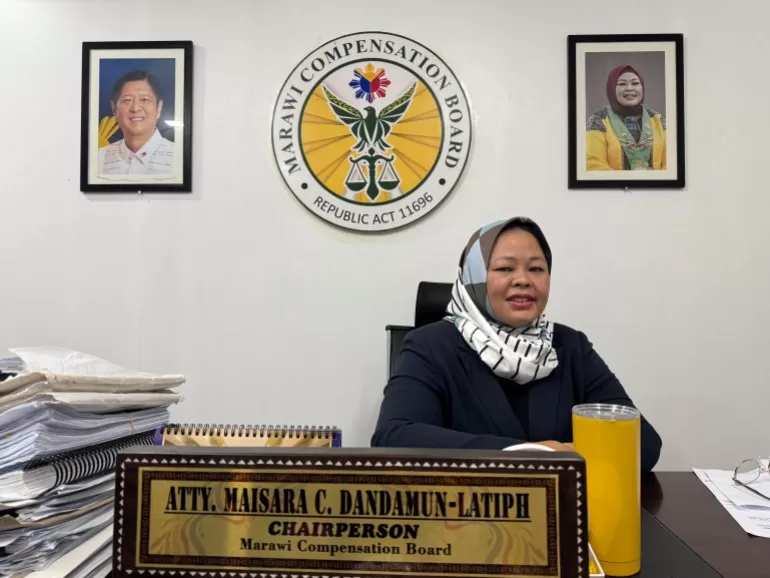Marawi, Philippines – Maisara Dandamun-Latiph’s office sits on a hill overlooking the ruins of Marawi, the southern Philippine city that was destroyed during a five-month battle with hardline fighters linked to the ISIL (ISIS) group in 2017.
Dandamun-Latiph was named chairperson of the Marawi Compensation Board in 2023, after years of promises to rebuild the city came to nothing.
Now, Marawi residents are finally beginning to receive payouts, in a compensation process that also must navigate a frayed and fragile trust.
“We want the people to be on board with us,” Dandamun-Latiph told Al Jazeera. “The people deserve nothing less than very good service after what has happened.”
Marawi was completely destroyed after the Maute and Abu Sayyaf groups launched an attack in 2017, holding on to the city during a five-month siege before the Philippine military recaptured it.
Of the more than 1.1 million people who once lived there, most have not returned.
The administration of former President Rodrigo Duterte released more than $200m in funding to rebuild Marawi. But rather than new homes, the money went mostly to public infrastructure projects, such as a new lakeside stadium and convention centre, which now stand alone amid the ruins.
“It’s normal for [residents] not to be so trustful of government, especially with what happened,” Dandaman-Latiph said.

The Marawi Compensation Board was created by an act of congress in 2022 to handle claims of wrongful death and damaged or destroyed property. Last year, President Ferdinand Marcos appointed Dandaman-Latiph, a respected lawyer and civic leader, as its chairperson.
The board has received 14,495 claims so far and has approved 596, totalling about $16.8m for destroyed structures and civilian deaths. Some 87 civilians died in the siege, with Amnesty International accusing ISIL-affiliated fighters and the Philippine military of human rights violations.
All claims are processed in batches in the order they are received, said Dandaman-Latiph, who stressed the need for fairness in both determining compensation and hiring staff for the office.
“It has to be based on merit,” she said. “Otherwise, this office will fail.”
A hopeful process
Dandamun-Latiph’s office is full of claimants on any given day, many of whom she knows by name. As she walks along the corridor to her office, she chats with an elderly woman, then spins around and crouches down to greet a child.
“Here, everybody knows everybody,” she said.
Faisah Dima-Ampao, a Marawi native, had just returned to the city in 2017 after working in Saudi Arabia for 36 years.
When the fighting began, her mother did not evacuate, believing – as many did at the time – that it would last only for a few days. Her mother has never been found, and the family home was completely destroyed.

After the siege, Dima-Ampao’s family received about $1,400 from a government task force, along with sacks of rice, chicken and groceries that were “only enough for one month for a small family”, she said.
Dima-Ampao compares her situation unfavourably to survivors of conflict in Syria and Lebanon, where she says governments rebuilt housing within one or two years. “But in Marawi, it didn’t happen,” she said. “They didn’t give us anything.”
Now, she feels somewhat vindicated by the compensation process, which she says has been smooth. She has received $6,100 in compensation for the death of her mother and is waiting for her family’s lost property claim to be processed.
The compensation board has embraced a data-driven approach, plotting damaged and destroyed properties on a 3D map and matching them against claims.
It also allows residents to prove property ownership via other means, like inviting witnesses, if their documents were lost in the siege.
“They just carried them, their families and their clothes on their back,” Dandaman-Latiph said. “We do not want to overburden them.”
‘A dead city’
But even as residents begin to receive compensation, the payouts will not rebuild the city of Marawi, which remains largely in ruins.
Marawi’s former commercial centre stands vacant. Weeds and wildflowers have taken over vacant lots and wound their way around the husks of the buildings.
Near the city’s largest mosque, which was quickly rebuilt after the siege, one family was rebuilding its house. Three blocks away, a man was selling dodol, a glutinous rice cake, from a street cart.
But the stores and restaurants that once made Marawi popular as a trading post and culinary destination have not returned, giving residents little incentive to come back.

The newly built stadium and convention centre stand on the shore of Lanao Lake – the jewels of the Duterte administration’s rebuilding project. However, they have rarely been used, and they’ve become targets for those wishing the money had gone to housing and job creation.
“You think that’s the priority of the people who don’t have any livelihood to play tennis or run or jog or do track and field or play football? What they need is to have a livelihood,” said Acram Latiph, a professor at Mindanao State University.
“There were a lot of resources wasted,” he said. “All they did was prolong the agony of the people.”
Last December, a bombing attack during a Catholic mass at Mindanao State University was a reminder of the threats that remain in the region.
Four people were killed and at least 50 injured in an attack that was claimed by ISIL.
“It’s not a question of whether it will happen. It’s a question of when,” Latiph said. “They’re like cockroaches.”
Still, many residents blame the authorities for what happened to Marawi and question whether the siege had to happen in the first place.
“They said let’s just sacrifice Marawi and compensate the people afterwards,” he said. “It was a hard decision.”
Latiph is hopeful that the compensation board will give residents long overdue relief, but he is sceptical about whether Marawi will ever be rebuilt.
“It’s a dead city already,” he said. “I don’t expect the city to return back to what it was before.”

